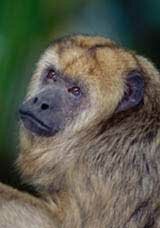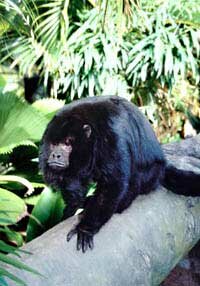 Black Howler Monkey Black Howler Monkey
scientific name
Alouatta caraya
size
Weight: Male 16 lbs " Female 12.5 lbs.
Head and Body Length: Male 18.1-28 in. " Female 15.2-22.3 in.
Tail length: Male 19.1-29.2 in." Female 19.1-27.3 in.
Females ~80% of size of males.
characteristics
Color: Long coarse hair" Male black, female and juveniles yellow-brown
Body: Head low on shoulders giving a hunched look " Arms and legs long in proportion to body " prehensile tail, naked on the underside " prehensile hand, thumb pseudo-opposable " Genitalia prominent " Nipples located near armpits
Face: bare and darkly pigmented " Nostrils: close together " Lower jaw and neck: large, swelling under chin for the larynx, outlined by beard in male
Feet: Big toe opposable
Behaviour: Diurnal " Primarily arboreal, occasionally spend short periods on ground " Locomotion: Slow four-footed gait with prehensile tail ready to give support or intermittently grasping " Hang by arms or tail alone when feeding on slender terminal branches " Avoid leaps but will leap 3-4 yards after much hesitation " Able to swim if necessary " Tail always tightly coiled around branch when resting " Territory: Usually do not have an area of exclusive use but will defend the territory of current use by howling accompanied by shaking and breaking of branches " Vocalization: loud and persistent; deep howls or growls that can carry 1.8 mi. (3 km) in forest and 3.1 mi. (5 km) over water " Troop size: 3-19 with 1-3 adult males and 2-7 adult females
reproduction/life span
Life span: 16-20 yrs. in wild; 23 yrs. in captivity
Mate. Sexual Maturity: male 5 yr.; female 3-4 yr
Breeding season: Breed throughout year
Gestation.180-194 days " Interbirth interval: 7-15 months
Offspring: Births single, twinning occasional " Young will cling to mother for 1 yr
 diet diet
Wild: Primarily leaf eater, also buds, flowers and fruit, particularly figs " Feed in smaller branches of emergent trees
Zoo: monkey chow, vegetables, fruit, browse
habitat/range
Habitat: Tropical rain forest and mixed deciduous forest " Upper and middle canopy
Range: Eastern Bolivia, southern Brazil, Paraguay, northern Argentina.
status
not listed " studbook participant
other
Hunted for food and captured for export.
oregon zoo exhibit
Amazon
back to top
|


